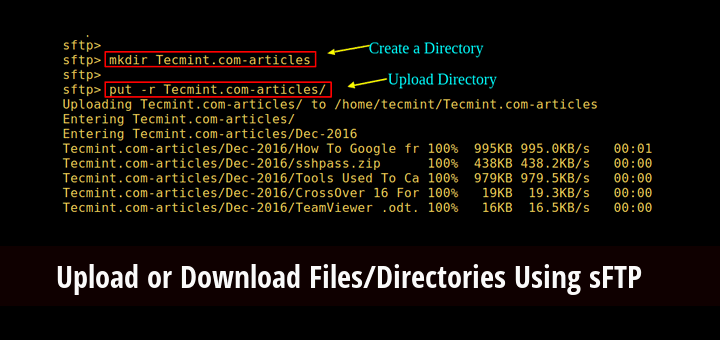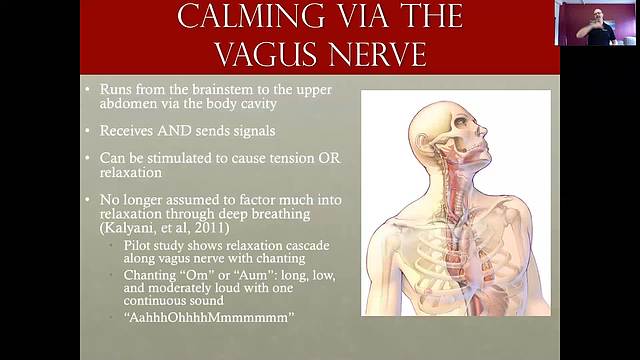The Tab key on your keyboard auto-completes names of directories and files you're starting to type. If you're going to cd into ~/Documents, then all you need to type is cd ~/Doc and then press Tab. This isn't just a pleasant convenience, it's also a way to prevent error. If you're pressing Tab and nothing's being auto-completed, then probably the file or directory you think is in a location isn't actually there. Rather than type every command, the terminal allows you to scroll through previous commands that you've run by pressing the up or down keys on your keyboard.
If you are writing the name of a file or directory as part of a command then pressing tab will attempt to auto-complete the name of what you are typing. If you want to move inside the tree, one option is to use relative paths. If you are in /home/sharon, then typing cd Downloads will work, because Downloads is an immediate child of your current directory. If you are in the subfolder Documents and want to change directory to Downloads, you have to go up (..) and then to Downloads. The shell uses the current working directory as the "root" or base directory for relative paths.
You can use theCDPATH environment variable to set another location as the base directory for relative paths. If you spend most of your time in a certain section of the filesystem tree, this can save you a lot of keystrokes every day. The /home directory on a Linux system contains a user's personal files, applications, and subfolders. You can simply run the cd command without passing any arguments if the $HOME environmental variable is set to your home directory path. If not then, the home directory has a tilde (~) character assigned to it.
This can be passed with the cd command to change the current working directory to /home without specifying the complete path of your home directory (/home/username). This is an example of changing a directory by giving an absolute path. In Linux, every file and directory is under the top-most directory, which is called the "root" directory, but referred to by a single leading slash "/". An absolute path indicates the location of a directory in relation to this top-level directory.
This lets us refer to directories in an unambiguous way from any place in the filesystem. On Linux and other Unix-like operating systems, the cd command can change the current working directory. Working in the current directory of a computer is also referred to as the user's current directory.
In this article, we will dive deeper into the cd command and give you a brief on cd up one level Linux. We've learned how to use pwd to find our current location within our file system. We've also learned how to use cd to change locations and ls to list the contents of a directory.
Now we're going to learn some additional commands for moving around within our file system. Therefore, our current working directory has changed to Desktop. The Linux cd command offers several ways to navigate and change the working directory using the terminal window. It lets you change directories using relative and absolute paths, move to parent or root directories, or find directories with incomplete names.
Ls is the command, with an option -F and anargument /. Sometimes options and arguments are referred to as parameters. A command can be called with more than one option and more than one argument, but a command doesn't always require an argument or an option.
Try navigating through your system using the terminal. As long as you restrict yourself to the cd, ls, and pwd commands, you can't do any harm, and the practice will help you get comfortable with the process. The absolute pathname is a complete path to the directory starting with the / folder whereas the relative pathname is derived from the current working directory. The ls command lists the content of the current directory . It can be used with the -l flag to display additional information about each file and directory in a list format. The -a flag allows you to view files beginning with .
The ls command lists the contents of the directory that you are currently in . The -la component of the command is what's known as a 'flag'. Dotfiles usually act as configuration files for software and as they are written in text, they can be modified by simply editing them. Linux cd command is used to change the current working directory ( i.e., in which the current user is working). The "cd" stands for 'change directory.' It is one of the most frequently used commands in the Linux terminal. On the other hand, the relative pathname is derived from the current working directory.
You can move up and down the directory tree efficiently with the cd command if you're well-versed on relative paths. After reading this tutorial, you should be able to use the Linux cd command to navigate and change the current working directory in the terminal window. It's used when you're in a shell session (for example, when you've launched a terminal window from a graphical desktop) to change the current working directory. So far, when specifying directory names, or even a directory path , we have been using relative paths. When you use a relative path with a command like ls or cd, it tries to find that location from where we are, rather than from the root of the file system. The current working directory is represented by a single dot (.) in Linux operating systems.
The parent directory, or the directory above the current one, is represented by two dots (..). The parent directory, in simple terms, is the directory that contains one or more sub-directories. Upon creating a new user, the contents of /etc/skel/ will be copied to the new user's home folder.
You can add or modify dot-files such as the .bashrc in /etc/skel/ to your requirements, and this version will be applied to new users. Before changing directories, we may need to list the current working path or other path directories. The ls command can be used to list files and directories.
This will display a list of folders in your current working directory and hidden files. However, to change the current working directory to of where you are, you can use the absolute path. Any path that starts with a forward slash / is an absolute path. Command line shells on Windows usually use the Windows API to change the current working directory, whereas on Unix systems cd calls the chdir() POSIX C function. This means that when the command is executed, no new process is created to migrate to the other directory as is the case with other commands such as ls.
This is because, when a new process is created, child process inherits the directory in which the parent process was created. If the cd command inherits the parent process' directory, then the objective of the command cd will never be achieved. Cd command in linux known as change directory command. Often, you may want to change the current working directory, so that you can access different subdirectories and files.
The home directory has a special character assigned to it---the ~ character. Use either absolute pathnames or local pathnames with the cd command. An absolute pathname starts at the root directory whereas a local pathname is relative to the current working directory. Where an absolute pathname starts from the root directory and leads to its destination, a relative pathname starts from the working directory. To do this, it uses a couple of special notations to represent relative positions in the file system tree.
An absolute pathname begins with the root directory and follows the tree branch by branch until the path to the desired directory or file is completed. For example, there is a directory on your system in which most programs are installed. This means from the root directory there is a directory called "usr" which contains a directory called "bin". To change the working directory we use the cd command.
To do this, we type cd followed by the pathname of the desired working directory. A pathname is the route we take along the branches of the tree to get to the directory we want. Pathnames can be specified two different ways;absolute pathnames or relative pathnames. Since the command line interface cannot provide graphic pictures of the file system structure, we must have a different way of representing it.
To do this, think of the file system tree as a maze, and that we are standing in it. At any given moment, we are located in a single directory. Inside that directory, we can see its files and the pathway to its parent directory and the pathways to the subdirectories of the directory in which we are standing. These two commands have the same effect, they both take us to the .hidden directory.
The first uses the absolute path, giving the full address from the home directory. The second uses a relative path, giving only the address from the working directory. By default, the ls commands lists the contents of the working directory (i.e. the directory you are in). You can always find the directory you are in using the pwd command. However, you can also give ls the names of other directories to view.
Navigate to your home directory if you are not already there. This file usually contains shell configuration settings. You may also see other files and directories beginning with .. These are usually files and directories that are used to configure different programs on your computer. Is used to prevent these configuration files from cluttering the terminal when a standard ls command is used.
Probably since the old shells didn't display the name of the current directory in the prompt, it was helpful to see the name of the directory when you typed cd -. For example when you type cd /usr/local you know that you are in /usr/loal, but when you type cd - you don't always remember from which directory you came from. In your home folder you will find a hidden file called .bashrc which contains some user configuration options. Changes made in this file will be actioned the next time a terminal is opened, since that is when the .bashrc file is read.
The contents of the user's desktop is in a directory here called Desktop, along with other files and folders. Which means the parent directory of the current working directory. It will simply express one level upper or parent directory. Print the current working directory with the pwd command. Pwd command is used in order to print current working directory.
Current working directory is the directory where the terminal currently running. In some cases listing or displaying current working directory will be usefull before changing directory. Depending on the situation, you probably don't want to and fortunately, there are command-line tools that make it extremely easy to create new directories and files. Are you tired of running multiple cd commands and ls commands while searching files and directories on your system? Cdir is a cool and easy-to-use command-line utility that provides a pleasant way to navigate the bash shell and search for files. On Unix-like operating systems, the cd command ("change directory") changes the shell's current working directory.
A relative path is a path that starts from the current working directory. For a path to be relative, it must start either with a dot and a slash (./) or nothing. Cd stands for "change directory" and is used to change the current working directory. The working directory is the one that you are currently interacting with. Every time you specify a command, you are using it within the working directory.
On a Linux system, the /home directory is a special directory reserved for a user's personal files, programs, and subfolders. When you log in to your system, the home directory is set as the current working directory by default. Before you can use the cd command to its full extent, you must know the difference between absolute and relative pathnames. The absolute pathname is the complete path to the directory, starting from the / folder. The current working directory is the directory or folder where you are currently working.
You can use the cd command to change the current working directory or move around the file system. To change to the current working directory's parent directory, type cd followed by a space and two periods and then press . To change to a directory specified by a path name, type cd followed by a space and the path name (e.g., cd /usr/local/lib) and then press . In Linux, both directories and files incur permissions.
Now we can see that we have changed the current working directory to/usr/bin and that it is full of files. As a convenience, it is usually set up to display the name of the working directory. Explore the options for ls to find out how to see hidden directories.
List the contents of the directory and identify the name of the text file in that directory. This allows us to move to our shell-lesson-data directory from anywhere on the filesystem (including from inside exercise-data). To find the absolute path we're looking for, we can use pwd and then extract the piece we need to move to shell-lesson-data. On many systems, the command line Desktop directory is the same as your GUI Desktop. Take a look at your Desktop to confirm that your output is accurate.
When you log into your server, you are typically dropped into your user account's home directory. A home directory is a directory set aside for your user to store files and create directories. It is the location in the filesystem where you have full dominion. There's also a directory called dev in the root directory of the filesystem.





























No comments:
Post a Comment
Note: Only a member of this blog may post a comment.